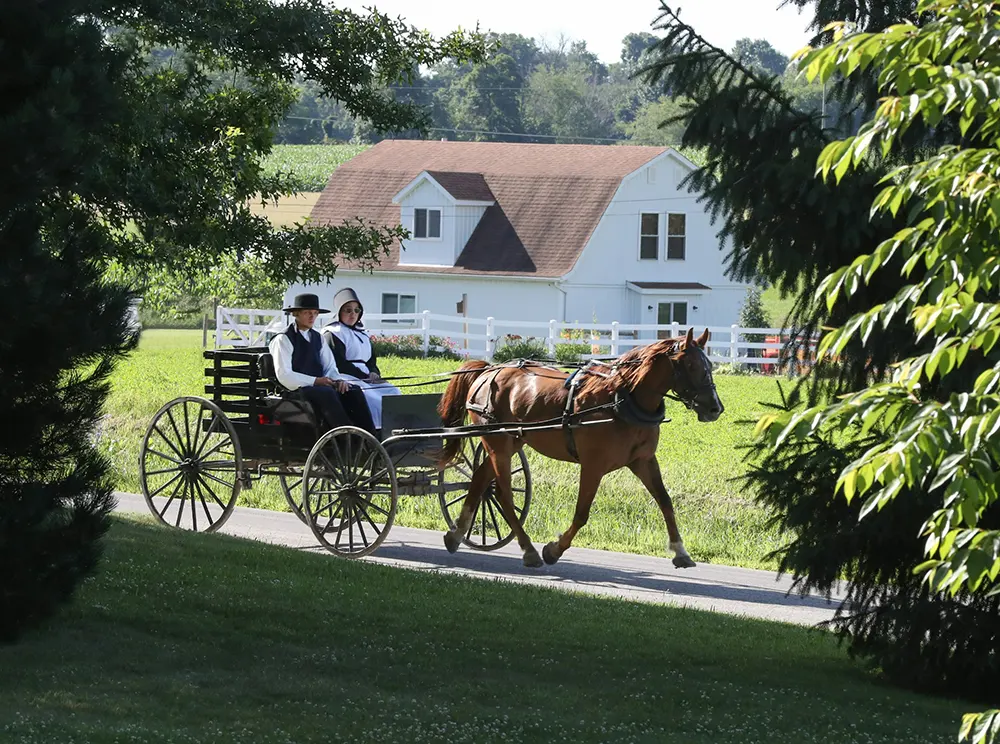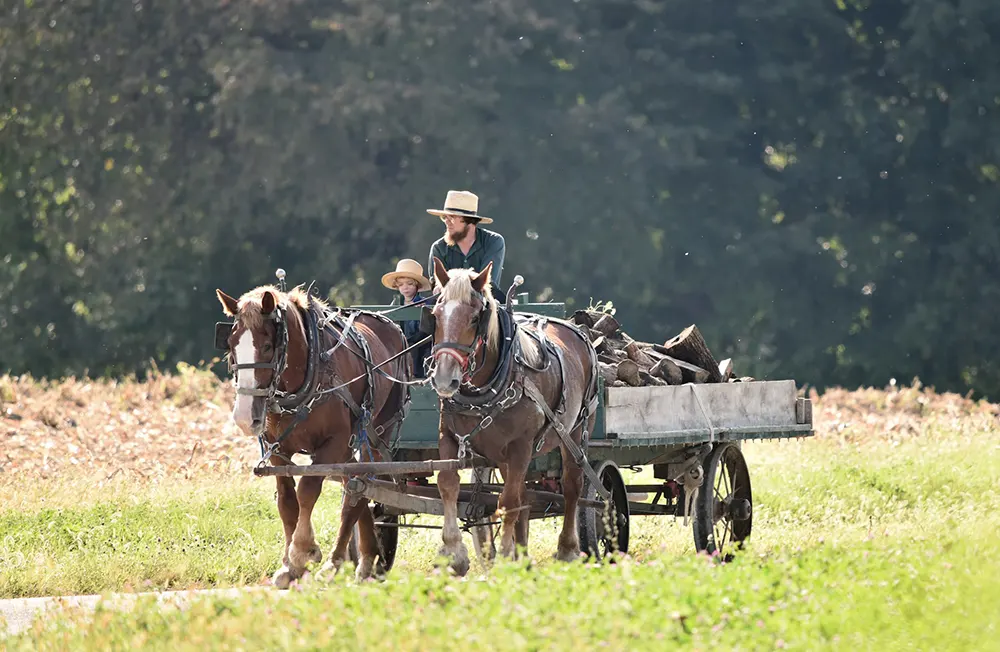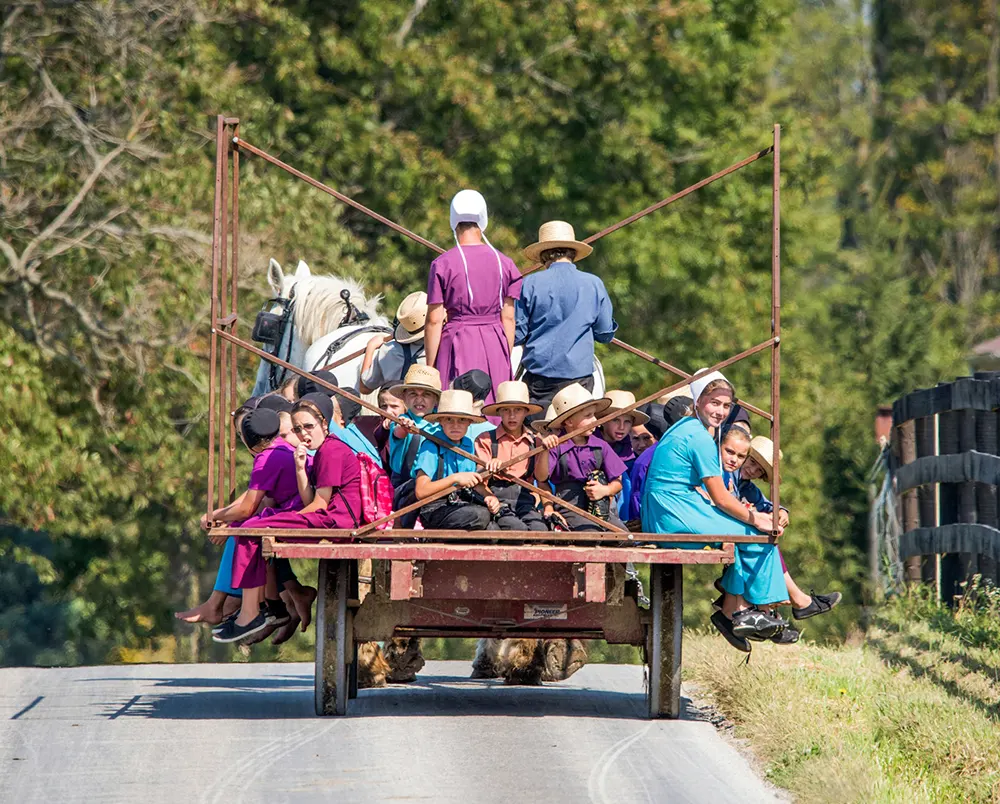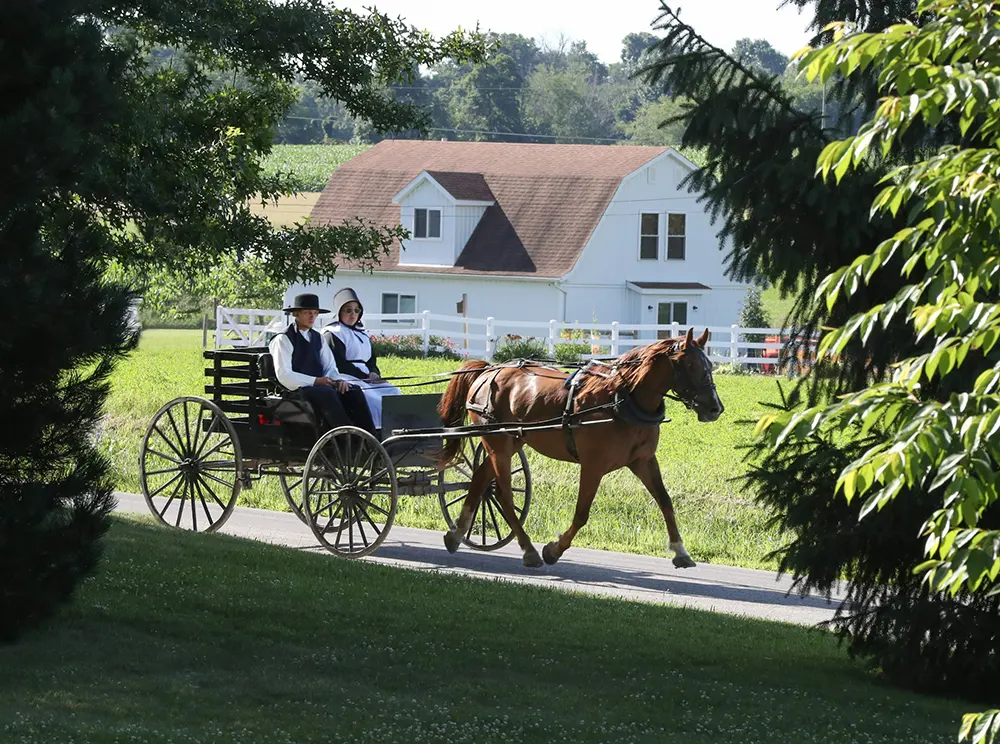
California, bathed in sunshine and boasting rich farmland, attracts many seeking a simpler life. It seems like a perfect fit for the Amish, renowned for their traditional values and self-sufficient practices. Surprisingly, that’s not the case.
Key Takeaways
- No established Amish communities exist in California due to factors like distance from existing settlements, high land costs, and cultural mismatch.
- The short-lived attempt in Salinas (1913) failed due to environmental challenges, social isolation, and internal conflicts.
- California has religious groups like Mennonites and German Baptists who share some practices with the Amish but are more adaptable to the modern world.
- The lack of Amish communities affects perceptions of communal living and limits Californians’ direct exposure to this culture.
This article explores the short-lived history of California’s near-Amish community and the reasons why the state, despite its agricultural abundance, might not be the most welcoming place for these traditional groups.
The Short-Lived Amish Settlement in Salinas, California
Drawn by the appeal of Salinas, California’s farmlands, the Amish from McMinnville, Oregon, chose to move to California in 1913, which was part of a trend among Amish communities seeking new frontiers.
With its agricultural promise, Salinas seemed an ideal match for their simple, agrarian lifestyles. However, this settlement was to be short-lived, dissolving just a year later due to various circumstances.
Upon arriving in Salinas, the Amish settlers encountered a landscape different from what they were accustomed to. The group, composed of families who had experienced disunity in their previous settlement in Oregon when their leaders started to move away, was looking for a fresh start.
Eventually, several Amish families from Illinois and Kansas joined them. They formed a community goal of establishing their traditional way of life in this new setting.
The early days were good as the community enjoyed the mild winter climate, which seemed favorable to their farming methods. However, their new environment soon revealed unforeseen problems.
Environmental Challenges
The settlers were unprepared for the agricultural demands of California’s climate, which required significant irrigation efforts contrary to their traditional farming practices.
As the New York Times stated about the state’s water issues, “Water is a currency in California, and the low-income farmworkers who pick the Central Valley’s crops know it better than anyone.” In addition, frequent fogs and a generally drier climate complicated their agricultural routines, which relied heavily on more predictable weather patterns.
Economic and Logistical Strains
High land prices in California made it difficult to acquire sufficient farmland to support their community economically. Additionally, the distance from established Amish colonies hindered logistical support and challenged maintaining connections.
Cultural and Religious Isolation
The community struggled with cultural isolation from non-Amish neighbors and the wider Amish network. This isolation was exacerbated by internal conflicts and the departure of key community members, including a deacon who left unexpectedly two months after their arrival.
Superstitious and Social Strains
An unusual thunderstorm in January 1914 led local non-Amish residents to superstitiously blame the Amish for the weather, enabling social tensions. That incident emphasized the cultural barrier between the Amish settlers and the predominantly Catholic locals.
Why California Does Not Host Amish Communities
Since the early 1900s, California has presented both opportunities and challenges. For the Amish, the state’s environment poses several formidable barriers.
Distance
One of the primary reasons California has not been a feasible location for Amish communities is its distance from the established colonies in the Midwest and East Coast. This geographic separation affects everything from the basic logistics of moving families to maintaining the tight-knit community interactions central to Amish life.
Goods transportation and regular travel between communities become impractical and expensive over such long distances. The lack of proximity to other Amish groups complicates social and economic exchanges. It isolates members from the larger support network that helps sustain their lifestyle.
Economic Barriers
California’s economic landscape also presents significant challenges. The high cost of land is the most daunting issue.
In regions where Amish communities typically thrive, such as Lancaster, Pennsylvania, and Holmes County, Ohio, agricultural land is affordable, supporting their farming-based lifestyle.
On the other hand, California’s real estate prices, especially in areas suitable for farming, are among the highest in the nation, making it difficult for Amish families to purchase the large parcels of land needed for their farms and communal living.
Moreover, California’s economy is heavily skewed towards high-tech industries and urbanized service sectors, which are at odds with the Amish economic model. This discrepancy makes economic integration challenging and conflicts with the Amish ethos of simplicity and self-sufficiency.
Environmental Concerns
California’s environment adds another layer of complication. The state is prone to natural disasters, such as wildfires, earthquakes, and droughts, which can devastate communities and agriculture. These conditions pose risks for the Amish, whose farming practices are closely tied to predictable weather patterns.
The dry conditions of the Central Valley and the moist and cool weather of the coastal regions make traditional farming inconsistent. This typically involves a reliance on modern technologies that the Amish avoid.
Sociocultural Mismatch
The Amish’s avoidance of modern conveniences and technologies differs from the Silicon Valley ethos and California culture, which embrace innovation, connectivity, and speed. This mismatch extends beyond technology to include values and the pace of life.
California’s fast-paced, highly individualistic society contrasts sharply with the community-oriented, slow-paced Amish culture. Such differences worsen the difficulties of preserving Amish cultural identity in the state, making it less attractive as a potential settlement area.
Comparative Analysis of Amish Communities in Other States
Amish communities typically thrive in favorable conditions that support their way of life. Successful settlements blend traditional practices with selective participation in the broader market economy, allowing them to preserve their simple lifestyle while staying economically engaged.
The attempt in California lacked these favorable conditions, demonstrating that the success of Amish communities depends not only on their strong foundations but also on a supportive external environment.
Here’s a comparison of how Amish communities thrive better in states like Pennsylvania, Ohio, and Indiana compared to California.
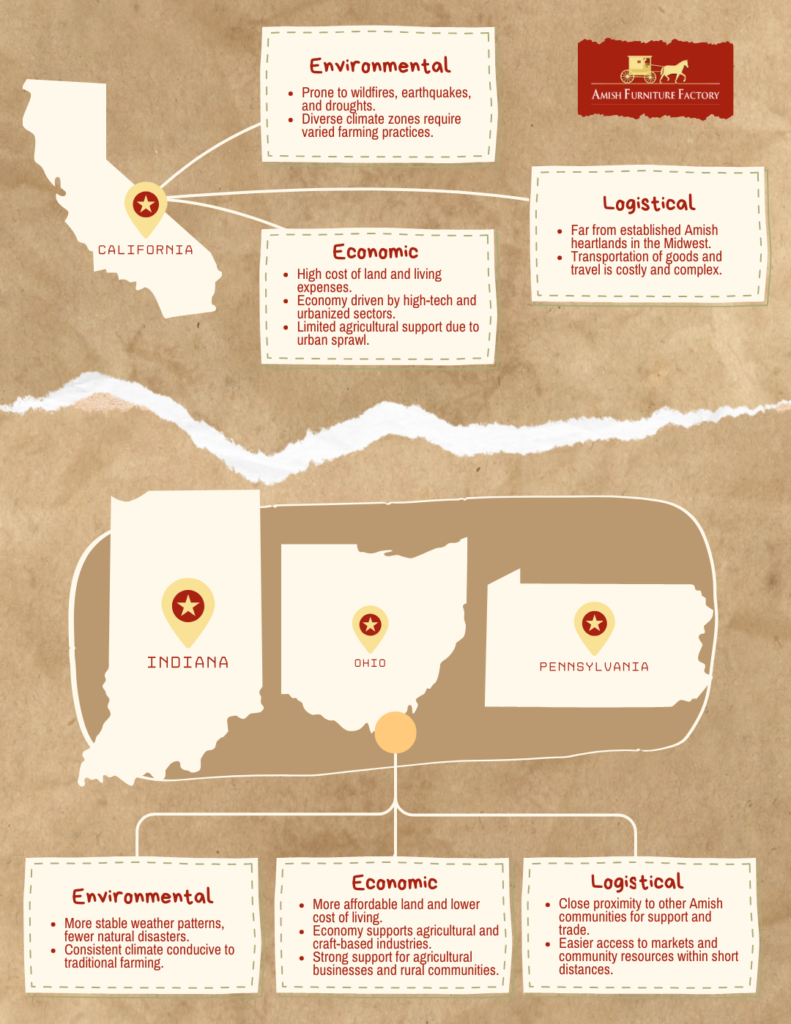
Pennsylvania
Pennsylvania offers a blend of fertile farmland and established networks that support traditional Amish livelihoods. The Lancaster County area, in particular, is synonymous with the Amish culture. It provides an ideal setting that balances rural seclusion with access to markets for Amish-made goods.
The community support structures here are strong: well-established schools, mutual aid practices, and a tourism industry that respects and integrates Amish heritage.
Ohio
Ohio has the largest Amish population in the country, particularly in Holmes County. This region provides affordable agricultural land and a climate supporting various crops essential to Amish farming.
Economic opportunities for Amish artisans and farmers are abundant here, with a solid local and tourist market for their products. Community ties are strengthened through church districts encompassing spiritual life and social and economic support systems.
Indiana
Northern Indiana, especially around Shipshewana and Nappanee, is another hub for Amish communities. Like Ohio, Indiana offers fertile land and a favorable climate. Its proximity to larger markets in Chicago and Indianapolis also offers unique economic opportunities.
This access allows Amish artisans and producers to reach a broader audience, enhancing economic viability. Community infrastructure, including schools, markets, and healthcare tailored to Amish needs, is well-developed, promoting long-term community sustainability.
Are There Similar Religious Communities in California?
While California may not host traditional Amish communities, it is home to several other religious groups that share some similarities with the Amish. These groups have found ways to adapt their lifestyles to California’s unique environment, maintaining their cultural practices amid a state known for its diversity and innovation.
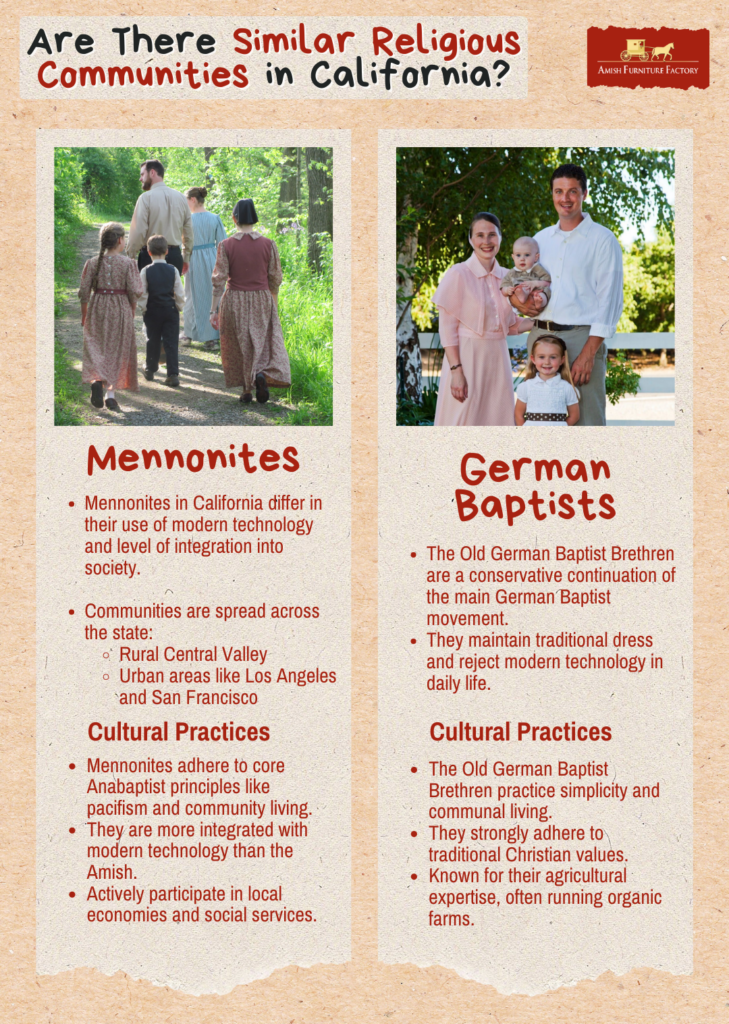
Mennonite Communities in California
Brian Froese, an associate professor of history at Canadian Mennonite University, offers a nuanced view of Mennonite history in California. He notes:
“Although we know of a few Mennonites who dug for gold in the 1850s, the real story of Mennonite religious experience in California began in the 1890s with westward migrations for fertile soil and healthy sunshine.”
He elaborates in his book California Mennonites, published by Johns Hopkins University Press,
“By the mid-twentieth century, the Mennonite story in California develops into an interesting tale of religious conservatives, traditionally agrarian, finding their way in an increasingly urban and always religiously pluralistic California.”
Unlike the Amish, Mennonites are more open to modern technology and society. However, they still adhere to many core Anabaptist principles, such as pacifism, community living, and focusing on manual labor and simplicity.
In California, Mennonite communities can be found in rural areas of the Central Valley and suburbs like Los Angeles and San Francisco. These communities vary in adherence to traditional practices; some may use modern technologies extensively, while others choose a more conservative path, similar to the Amish.
For example, in places like Fresno and Modesto, Mennonites run several successful manufacturing or retail businesses that reflect their strong work ethic and communal values.
German Baptist Groups
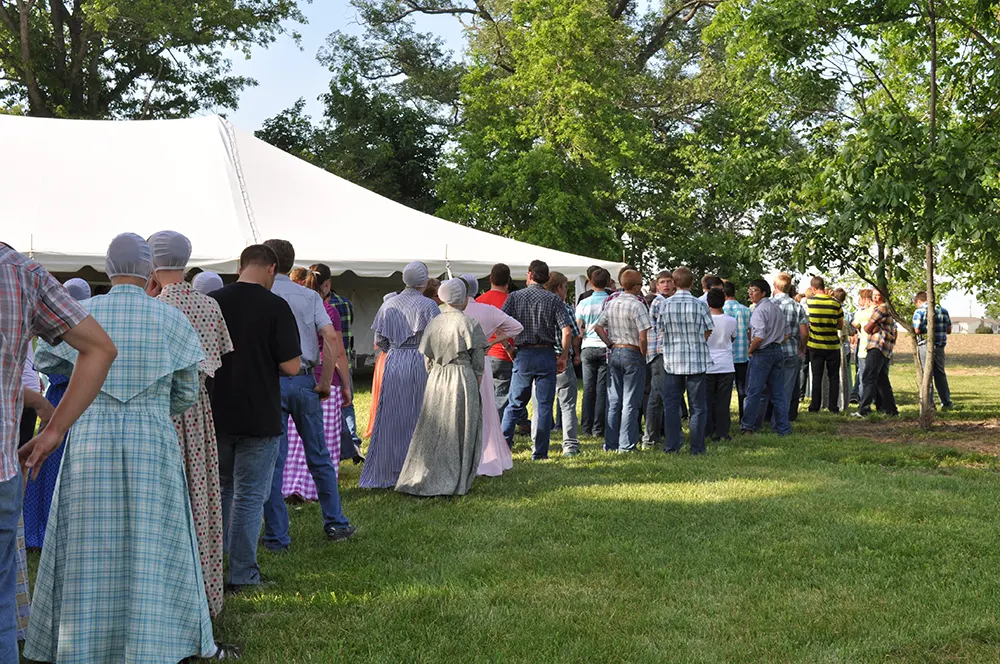
German Baptist groups exist in California, particularly the Old German Baptist Brethren. This group split from the main body of German Baptists in the late 19th century to maintain a more traditional lifestyle.
Today, their communities in California are small but passionate, emphasizing simplicity, modesty in dress, and separation from mainstream culture that echoes Amish traditions.
German Baptists in California are known for their agricultural acumen. They often run small-scale family farms focusing on organic and sustainable practices. These farms are not only a source of livelihood but also serve as community centers where members meet for worship and social events.
California’s climate supports their farming practices with its ample sunshine and fertile soil. However, like the Amish, they face water scarcity and high land costs.
Other Religious Communities in California
Aside from the Mennonites and German Baptist groups, more religious communities currently reside in California.
- Quakers (Friends): California has several Quaker meetings throughout the state. Quakers, or Friends, are known for their commitment to nonviolence and simplicity, similar to Anabaptist groups. They often engage in community service and activism related to peace, social justice, and environmental stewardship.
- Hutterites: Although more common in the northern United States and Canada, Hutterites share communal living practices similar to the Amish but are distinct in their collective ownership of goods and communal living.
- Eastern Orthodox Monastic Communities: California hosts several Eastern Orthodox monasteries that adhere to ancient Christian traditions of monastic life, emphasizing communal living, daily prayer, and spiritual contemplation.
- Buddhist Communities: California is notable for its significant Buddhist population, including many monastic communities. These communities are centered around meditation, teachings, and living by Buddhist principles. Places like the City of Ten Thousand Buddhas in Ukiah represent one of the largest Buddhist communities in the Western Hemisphere.
- Hindu and Sikh Communities: Numerous Hindu temples and Sikh gurdwaras are also located across California. These communities serve as places of worship and cultural centers for the state’s large Indian-American population.
Implications of the Absence of Amish Communities in California
The lack of Amish communities in California offers valuable insights. It helps us understand its influence on local views of community and religion and its broader cultural and economic impacts.
Local Perceptions of Communal and Religious Lifestyles
The absence of Amish communities in California means that many Californians only encounter Amish culture through media portrayals rather than direct, personal interactions. This distance can lead to misconceptions or romanticized views of the Amish lifestyle, skewing public understanding of communal living.
In regions where Amish communities thrive, they often serve as a counterpoint to the individualistic, fast-paced modern lifestyle, offering a model of living that emphasizes family cohesion, community support, and sustainable practices.
Without this model, Californians may lack tangible examples of alternative living that prioritize community over competition and simplicity over technological advancement. This absence also influences local religious groups, which often look to the Amish as an example of maintaining religious and cultural integrity in the face of modern pressures.
Culture
Culturally, Amish communities often bridge the past and the present, preserving traditional crafts, farming techniques, and lifestyles. Their approach to community living can inspire other groups seeking sustainable and integrated communal practices.
In California, where innovation is frequently celebrated, the presence of Amish communities could provide a grounded perspective on balancing tradition with progress. They would demonstrate that advanced technology and rapid growth can coexist with, and even benefit from, a more deliberate pace of life and a focus on sustainability.
Moreover, Amish craftsmanship, known for its quality and sustainability, could influence California’s artisan markets, potentially leading to a greater appreciation for handcrafted goods and locally sourced materials. This influence could spur growth in local crafts and sustainable practices, enriching the state’s cultural tapestry.
Economy
With its extensive markets and tourism industry, California could benefit from Amish communities’ unique offerings – from organic produce to high-quality, handcrafted furniture and goods.
The Amish’s self-reliance and sustainability could also offer valuable lessons in economic stability. It shows how communities can thrive economically by fostering close ties and minimizing reliance on external economies.
Their presence could encourage more sustainable agricultural practices in nearby communities, potentially leading to broader adoption of organic and non-GMO farming methods with a lesser environmental impact.
Experiencing Amish Culture: Tourism and Educational Opportunities
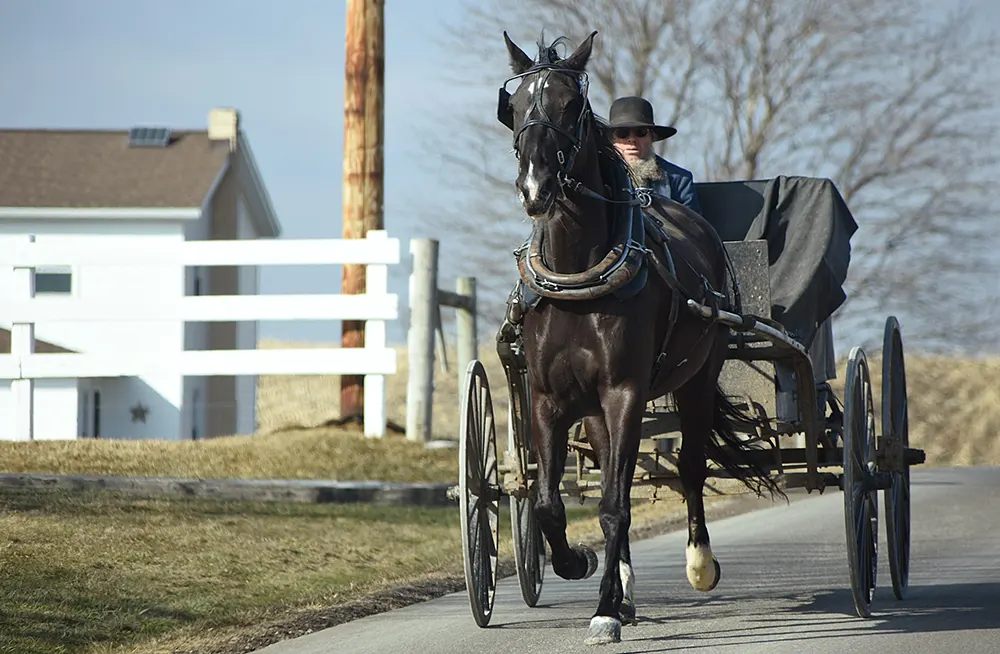
For those residing in California, the temptation of experiencing Amish culture first-hand might seem a distant possibility, given the absence of Amish communities within the state. However, the intriguing Amish life can be explored through organized trips and educational programs in states where Amish communities thrive.
Here’s how Californians can experience the authentic Amish experience and better understand this unique cultural heritage.
Visiting Traditional Amish Communities in Other States
One of the best ways for Californians to experience Amish culture is to visit states like Pennsylvania, Ohio, and Indiana- where Amish communities are not just surviving but prospering. These states offer a variety of tourism opportunities that allow visitors to see and interact with the Amish way of life up close.
- Pennsylvania’s Lancaster County is the most iconic Amish region in the United States. Here, visitors can take guided tours that offer insights into Amish history, farming practices, and daily life. These tours often include visits to Amish farms, schools, and markets, providing a broad look at the community’s way of life.
- Ohio’s Holmes County is home to the largest Amish population in the world. Tourists can explore the communities here by taking buggy rides, visiting Amish-run businesses, and sampling traditional Amish meals in a family’s home.
- Indiana’s Amish Country, around towns like Shipshewana and Nappanee, is known for its artisanal crafts and furniture. Tourists can visit workshops where Amish craftspeople traditionally create goods, offering a tangible connection to Amish craftsmanship.
Recommended Tours and Locations
When planning a visit, it’s recommended to look for tours that respect the privacy and traditions of the Amish. Many tour operators work closely with the Amish communities to ensure that visits are conducted respectfully and informatively without being intrusive.
Here are a few recommended experiences:
- Amish Village Tours in Lancaster deeply explore the Amish’s history and life. These tours are great for understanding the complexities of Amish culture beyond the horse-drawn carriages.
- Shipshewana Amish Experiences in Indiana allow visitors to participate in traditional Amish meals, witness quilt making, and even attend Amish church services, depending on the time of year and community events.
- Holmes County’s Backroads Tours offer a more intimate look at the Amish way of life, often taking visitors through lesser-known areas of the community.
Educational Programs and Cultural Exchanges
For those looking for more than just a visit, educational programs, and cultural exchanges provide more profound wisdom into Amish traditions. These programs are designed to educate outsiders about the Amish philosophy on technology, their educational system, and their religious beliefs.
Several universities and cultural institutions offer workshops and seminars that tackle Anabaptist history, the theological underpinnings of the Amish faith, and the sociological aspects of living without modern technology.
Additionally, some Amish communities host visitors for extended stays through cultural exchange programs, where participants live alongside an Amish family and participate in daily chores and community activities.
Amish Culture Through Products and Food
Due to their distance from California, finding authentic Amish-made food and goods in mainstream stores can be a challenge. However, there are still ways to obtain these high-quality, handcrafted items.
Here are some of the commonly available Amish-made goods you might find in California:
Furniture

Amish furniture is known for its durability, timeless designs, and expert craftsmanship. You might find a variety of furniture pieces, from dining tables and chairs to bedroom furniture and outdoor furniture, at specialty stores, furniture expos, or directly from Amish woodworkers who ship their products across the country.
Baked Goods
Amish communities are famous for their delicious baked goods such as Amish Friendship Bread, often made with fresh, local ingredients and traditional recipes. While fresh bread, pies, and cookies might be difficult to find due to their perishability, you might get lucky and find shelf-stable items like jams, jellies, and honey at local farmers markets or specialty stores.
Quilts
Amish quilts are known for their intricate patterns, vibrant colors, and superior quality. These beautiful and functional pieces of art are often made with hand-stitched techniques and passed down through generations. You might find a good selection of Amish quilts at craft fairs, quilt shows, or online retailers specializing in handmade goods.
Baskets
Amish baskets are known for their sturdiness, versatility, and beautiful weaving patterns. These baskets can be used for storage, laundry, or even as decorative pieces for your home. Look for them at farmers markets, craft stores, or online retailers.
You might also be interested to explore the Amish communities in Georgia.
Reflecting on the Future: Amish Presence in California?
The absence of Amish communities in California highlights an iconic difference between Amish values and the state’s modern lifestyle. While significant challenges such as high land costs and environmental risks make traditional settlements unlikely, California’s evolving appreciation for sustainable living might open doors for new forms of collaboration.
Future possibilities could include small-scale partnerships that blend Amish craftsmanship with Californian innovation, particularly in areas like organic farming or sustainable construction. Such initiatives could offer mutual benefits, combining Amish traditions with modern technologies that respect their values.
While traditional Amish settlements may not be feasible, their principles of community and sustainability could still find a place in California’s cultural landscape, fostering unique economic and cultural exchanges.
Frequently Asked Questions
Where is Amish in California?
There aren’t any established Amish communities in California with the traditional characteristics of self-sufficient, close-knit settlements. The Amish lifestyle thrives on factors like distinct seasons and rural settings, which California’s climate and culture might not provide as readily.
Is there anything similar to Amish communities in California?
While lacking large Amish settlements, California has communities with a focus on self-sufficiency and simple living. You might find groups centered around organic farming, alternative education, or religious traditions with shared values.
Why aren’t there many Amish in California?
The Amish lifestyle prioritizes self-sufficiency and traditional living. California’s climate and culture might not be ideal for their way of life compared to areas with distinct seasons and more rural settings.
